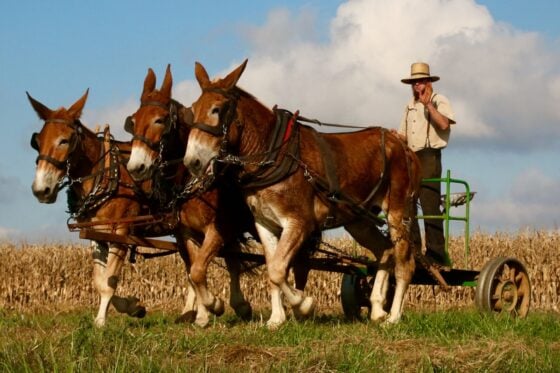The Amish & Money: How They Make & Use It
 Romantic portrayals of the Amish may have them doing business by barter, or producing the majority of the goods they consume, largely cut off from the non-Amish economy. In fact, Amish participate in modern commerce in a variety of ways.
Romantic portrayals of the Amish may have them doing business by barter, or producing the majority of the goods they consume, largely cut off from the non-Amish economy. In fact, Amish participate in modern commerce in a variety of ways.
Do Amish use money?
In reality, Amish do use money just like anyone else. Besides cash, the most common way of paying for goods, paying monthly bills, and making other transactions, is by check. Nearly all Amish adults will have a bank checking account. Married couples typically have a joint account, and an Amish youth will open his own account at age 21.
Additionally, some Amish use credit cards. This remains a minority of all Amish, perhaps 1/4 to 1/3 of households. As with non-Amish users, credit cards offer Amish convenience, and also a way to handle business expenses. Typically bills are paid off monthly, as Amish are unlikely to carry a balance or use credit cards for excessive consumption.
Amish shop at Wal-Mart & other stores
Amish are plugged in to the economy in other ways. While Amish make some of their own goods, and waste is frowned upon, Amish do shop at places like Wal-Mart, attracted to the low prices and bulk quantities offered.
An Amish housewife may travel with other housewives once a month to do a large shopping trip at a supermarket. She will share the cost of hiring an “Amish taxi”—usually a large van—and do a large amount of shopping at one time.
Most Amish homes have a garden, and Amish produce large amounts of their own food for canning. However, Amish will buy food and other household amenities—paper towels, disposable diapers, medicine and health items, etc—at stores as well.
Amish businesses market themselves locally & nationally
In addition to interacting with the economy as consumers, Amish also provide products and services to both their own Amish markets and non-Amish, or English, markets. The scope of their businesses can even reach far beyond their local communities to the nation as a whole, and even overseas.

Some Amish advertise their businesses on websites operated by third parties. Others have dealers who sell their goods, such as furniture, online and in retail stores scattered across the country. Research has shown that Amish-made furniture, in fact, may comprise even 10% of all domestic furniture shipments (“Wood Use”, Bumgardner/Romig/Luppold).
Other Amish work in upscale neighborhoods in metropolitan areas in the Midwest and East Coast, building new homes and renovating existing ones. Additionally, Amish participate in tourist industries that have developed in some of the larger communities. Amish do not exist in a bubble, and with the high price of farmland, they have been compelled to make a living by engaging local, regional, and even national markets.
Amish consumer culture?
Amish believe in simplicity and in living humbly. They stress equality before God’s eyes, and for many years, this sense of equality was replicated in the physical world.

When all Amish were farmers, with 8, 10 or more mouths to feed, most had similar income levels. Certainly few Amish would have been considered “rich”. Yet with rising land prices, and the shift from farming to running successful businesses, Amish have experienced previously unknown levels of wealth.
Some Amish fear the implications of this influx of wealth, seeing the development of a class system and status pressure in a previously classless society. Higher incomes have resulted in expensive vacations, more trips out, expensive hunting gear for men, and more of what previous generations of Amish would consider luxuries around the home.
It remains to be seen how well Amish society will retain core values in the face of financial success. The thoughtful Amish approach to modernity, resistance to change, and reliance on tradition all serve to hamper drastic changes in the values and composition of Amish society.
Regardless of how Amish will adapt to change in future, the fact remains that today’s Amish are largely plugged into the modern economy, and interact with that economy in fairly sophisticated ways.
For further information, see:
Amish Enterprise: From Plows to Profits, Donald B. Kraybill and Steven M. Nolt
Bumgardner, M., R. Romig and W. Luppold (2007). “Wood Use by Ohio’s Amish,” Forest Products Journal 57(12), 6-12.






Are Amish true followers of Christs teachings? Nope, if they use money... Luke 16:13. Just a cult, imo.
Hi,
I have yet to meet any one true christian who actually follows the teachings of Jesus Christ specifically Luke 16:13 “No one can serve two masters. Either you will hate the one and love the other, or you will be devoted to the one and despise/hate the other. You cannot serve both God and money.”
It’s become obvious that people are not willing to live homeless without using or accepting money in order to follow Gods commandments. Rather so-called professed “Christians” usually accept a sly excuse from satan as to trying to serve 2 masters, but none have given the satanic drug money/mammon up completely. I have and it feels great other than being homeless.
Matthew 7:
21 “Not everyone who says to me, ‘Lord, Lord,’ will enter the kingdom of heaven, but only the one who does the will [Deuteronomy 5] of my Father who is in heaven . 22 Many will say to me on that day, ‘Lord, Lord, did we not prophesy in your name and in your name drive out demons and in your name perform many miracles?’ 23 Then I will tell them plainly, ‘I never knew you. Away from me, you evildoers!’
Therefore in my view, any professing “Christian” who uses/accepts money will be told verse 23, “Then I will tell them plainly, ‘I never knew you. Away from me, you evildoers!’
Money is the root of all evil and evildoers. Using or accepting (non-breathing) money usurps/steals the trust we should have in our (breathing) neighbor. Use of money is absolute pledge/worshipping of false images/idols for goods and services. God did not make money.
Have you given up money so that any of your prayers can be heard or accepted? Why or why not, please use holy scripture, if you can, in a response. Listen to no man, first Gods commandments and then what Jesus says, no one else.
Drew.
I hear you Drew and understand your adherence to the verse. God did not make clothes, shelter, or the modern day food system either. So I ask in all seriousness what do you do about these topics? Do you forage for your food or grow it? We obviously use money but we do grow our own food, share with our neighbors, forage for medicinal herbs, and try to provide as much from the land as we can. I can’t imagine being homeless with my children…I would think I would have to rely on the generosity of others who are using said money society. Thank you in advance for your response and may God bless your faithfulness
@Drew
I’m not seeing in scripture where we are commanded to be homeless. When does God say not to build a cabin in the woods? Maybe that is breaking some form of trespassing law, but that’s man’s law, not God’s. Alternatively, lots of people squat in abandoned buildings without using money.
A gift economy?
Hello Erik, we have been hiring amish in the community we just moved to. But we have been getting questions like ‘can we hay your field?’ or ‘can we cut a cedar from your property’. It seems very presumptuous to ask for this kind of stuff. Or would this be participating in something like a gift economy? Do amish do this? We had been given a pile of wood posts.
I don’t want to be taken advantage of. But I also don’t want to miss out on participating in the community exchange.
I would just say, do what you feel comfortable with. Maybe the people think you are not planning to hay the field or won’t miss a cedar. You certainly don’t have to agree to anything that doesn’t seem fair. And those seem like pretty sizeable asks.